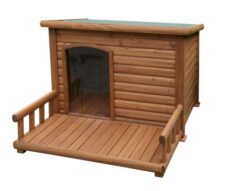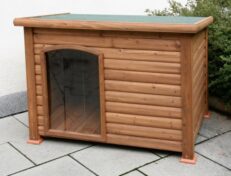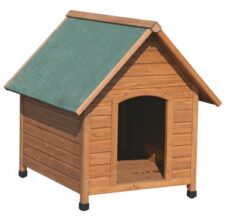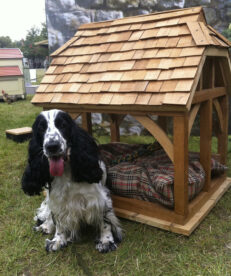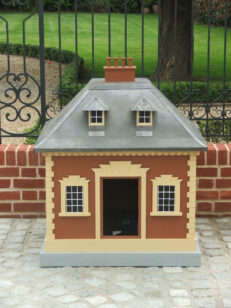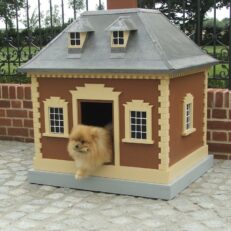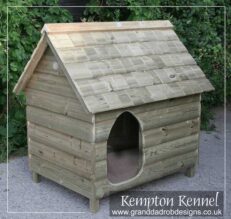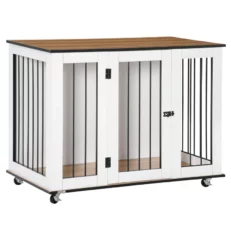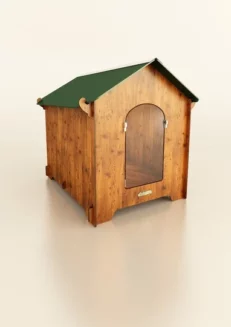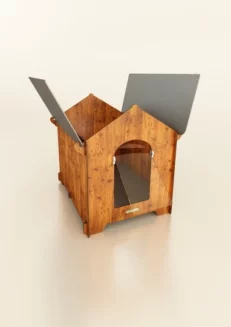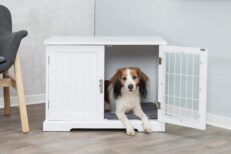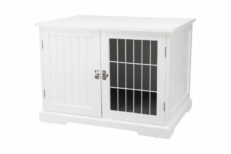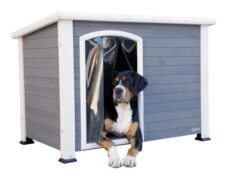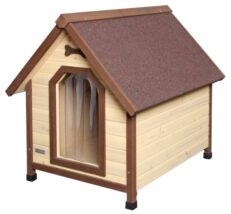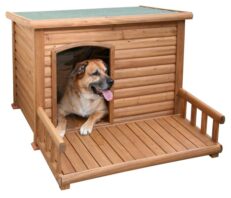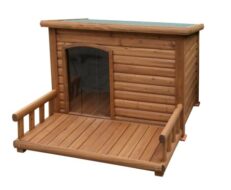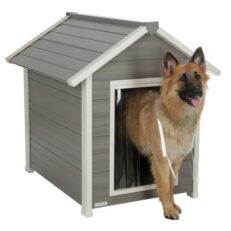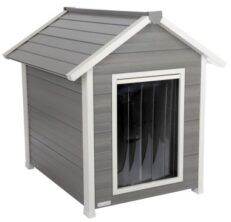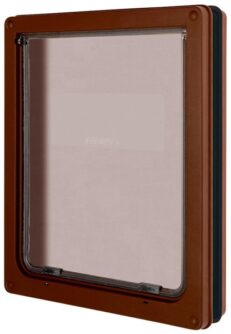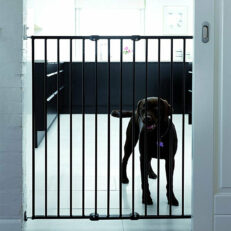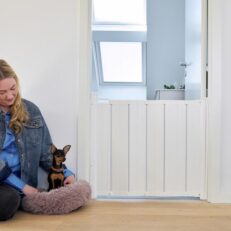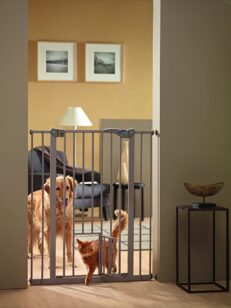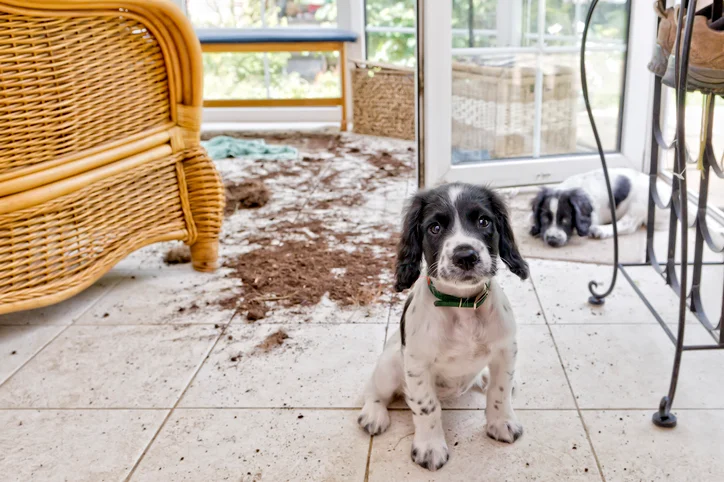
Welcome to our comprehensive guide on the art of dog-proofing your home, a vital endeavor for any dog owner or prospective pet parent. Within these pages, we aim to delve deep into the significance of dog-proofing, elucidate the multitude of advantages it confers, and provide you with a thorough roadmap to navigate this informative resource effectively.
Why does dog-proofing hold such paramount importance? It transcends mere safeguarding of material possessions; its core essence lies in preserving the well-being of your cherished furry companion. Dogs, driven by their innate curiosity, tend to interact with their surroundings through exploration, often using their mouths and paws. Such behavior can inadvertently expose them to potential hazards and accidents, all of which are entirely preventable with diligent implementation of dog-proofing measures.
A dog-friendly environment not only ensures the safety of your four-legged friend but also bestows a myriad of benefits upon you as a responsible pet owner:
A secure home environment grants you the luxury of relaxation and unbridled enjoyment of your canine companion’s companionship, free from the persistent specter of harm. Dogs that reside in a secure and comfortable setting tend to be healthier and exude a higher degree of happiness, which ultimately translates into a more vibrant and affectionate pet. Minimizing potential hazards within your home can dramatically lower stress levels for both you and your dog, fostering an atmosphere conducive to a harmonious relationship. A safer living space can extend your dog’s lifespan by averting accidents and mitigating their exposure to toxic substances. Proactive dog-proofing not only enhances your pet’s well-being but also shields you from incurring substantial veterinary bills resulting from accidents or toxic ingestions.
Our guide is meticulously crafted to serve as your ultimate compendium for all facets of dog-proofing your abode. As we traverse through the forthcoming chapters, anticipate the following: We shall embark on a room-by-room odyssey, spotlighting potential hazards and furnishing you with actionable insights to transform each space into a haven of safety for your beloved canine. A comprehensive catalogue of commonplace household items and foods that pose potential harm to your dog, accompanied by astute counsel on safeguarding them from your pet’s reach. Valuable insights into training methodologies to prevent undesirable behaviors and untoward accidents, fostering a cooperative and harmonious coexistence. Scrutinized reviews and informed recommendations for dog-proofing paraphernalia and tools to simplify your efforts. Prudent guidance on how to respond in the event of accidents or unforeseen emergencies, ensuring your dog’s safety and well-being. A convenient checklist, meticulously devised to aid you in a systematic and thorough dog-proofing endeavor.
By the culmination of this guide, you will possess a comprehensive toolkit to craft a secure and inviting haven for your cherished canine. So, let us embark on this journey towards a dog-friendly dwelling, where happiness, health, and harmony prevail for both you and your beloved four-legged companion.
Understanding Your Dog’s Needs
Before embarking on the journey of dog-proofing your home, it’s crucial to gain insight into your canine companion’s unique needs and behaviors. A profound understanding of your dog’s behavior and instincts lays the groundwork for creating a secure and comfortable living space tailored to their well-being.
Dogs, with their multifaceted personalities, possess distinct behavioral traits and instincts. To best cater to their needs, consider the following key points. Dogs are inherently pack animals. They thrive on social interaction and often perceive their human family as an integral part of their pack. Dogs are naturally curious creatures. They engage with the world around them predominantly through their senses, with their nose and mouth being their primary tools of exploration. Puppies and adult dogs alike have a strong inclination to chew. It serves not only as a teething remedy for puppies but also as a means to alleviate stress, combat boredom, and manage anxiety. Dogs exhibit territorial behaviors and may mark their territory with urine. They also crave a designated, safe space within your home. Regular exercise is vital for a dog’s physical and mental well-being. Insufficient physical activity can lead to behavioral issues and pent-up energy.
To effectively dog-proof your home, it’s essential to step into your dog’s world and identify potential hazards from their point of view. Some common hazards include. Small objects, toys, or food items that your dog could ingest and choke on. Chemicals, plants, foods, and medications that pose a toxic threat if consumed by your dog. Cords and wires that might entice your dog to chew on them, leading to electrical shocks or choking hazards. Items in the trash can be tempting to dogs and potentially dangerous if ingested. Unsecured gates or doors that could serve as an escape route for your dog. Furniture with sharp edges, fragile items, or unstable furnishings that could cause injuries. Areas where your dog might be at risk of falling or injuring themselves.
Now, let’s delve into how dog-proofing your home directly contributes to the happiness and health of your furry friend. Dog-proofing substantially reduces the risk of accidents, including choking, electrical shocks, or poisonings, ensuring your dog’s physical safety. Creating a dog-friendly environment minimizes potential stressors and provides a comfortable, secure space for your pup, contributing to their emotional well-being. Preventing destructive behaviors stemming from boredom or anxiety, such as furniture chewing or excessive digging, is a significant advantage of dog-proofing. By eliminating toxic substances and potential dangers, you prioritize your dog’s physical health, reducing the likelihood of costly vet visits. A dog that feels secure, loved, and content within its home is a happier dog. This fosters a deeper, more fulfilling bond between you and your four-legged companion.
In the forthcoming chapters of this guide, we’ll provide practical tips and strategies for dog-proofing your home, room by room. This comprehensive approach ensures that your dog’s specific needs are met, and they can thrive in a safe, happy environment. Stay tuned for our detailed room-by-room dog-proofing advice, which will empower you to create a haven that truly caters to your furry friend’s well-being.
The Essentials of Dog-Proofing: Protecting Your Pup
In this chapter, we embark on the essential journey of dog-proofing your home, a critical aspect of ensuring the safety and well-being of your cherished canine companion. This endeavor involves a meticulous evaluation of your living space, the creation of a secure environment, and a keen awareness of common household items that can pose risks to your furry friend.
Before diving into the process of dog-proofing, it’s paramount to perceive your living space through the eyes of your canine companion. Begin by taking a deliberate stroll through each room in your house, paying meticulous attention to potential hazards, such as electrical cords, small objects, or substances that might be harmful to your dog.
To truly comprehend your dog’s environment, get down on your hands and knees and explore each room from their eye level. This unique perspective empowers you to identify hazards that might otherwise escape notice when standing upright. Your dog’s safety extends beyond the interior of your home. It’s vital to ensure that all doors and gates leading outside are securely locked, guarding against potential escapes. This includes inspecting fences for gaps or doors that may not latch properly.
Recognize that different dog breeds possess varying needs and abilities. Tailor your dog-proofing strategy to suit your specific dog’s size and breed characteristics, guaranteeing a customized approach to their well-being.
With potential hazards identified, the next step involves the creation of a secure haven within your home for your pup. Allocate a specific area or room where your dog can play, eat, and rest without encountering any hazards. This designated space should be meticulously dog-proofed and equipped with essential items, including their bed, food and water dishes, and a selection of safe toys. Additionally, strategically install baby gates to block off areas that haven’t yet undergone dog-proofing. This practical measure allows you to control your dog’s access and prevents them from venturing into potentially dangerous zones.
Ensure your dog has access to a variety of safe, chewable toys. This not only keeps them entertained but also helps prevent undesirable behaviors, such as chewing on furniture or other household items. Lastly, opt for trash cans with secure lids that your dog can’t easily open. Moreover, store human food out of your dog’s reach, as certain foods are toxic to dogs and pose significant health risks.
Awareness of household items that can be harmful to your dog is paramount for their safety. Common culprits include toxic foods like chocolate, grapes, raisins, onions, garlic, and certain artificial sweeteners like xylitol. Exercise caution with cleaning products, detergents, and chemicals, storing them securely beyond your dog’s reach. Be mindful of houseplants such as lilies, poinsettias, and philodendrons, which can be poisonous to dogs if consumed. Safeguard all medications, whether prescription or over-the-counter, in a secure, sealed container, well beyond your dog’s reach. Lastly, exercise caution with small items such as coins, buttons, or rubber bands, which can pose choking hazards. Additionally, be mindful of electrical cords, as dogs may chew on them, leading to electrical shocks or even fires. Properly securing cords is essential for your dog’s safety.
In the forthcoming chapters of this guide, we will provide comprehensive, room-by-room dog-proofing tips, offering specific insights on how to address these common hazards. Our aim is to empower you with the knowledge and strategies needed to create a secure and harmonious living environment for your beloved furry companion. Stay tuned for our in-depth guidance on crafting a haven that prioritizes your dog’s safety and well-being in every corner of your home.
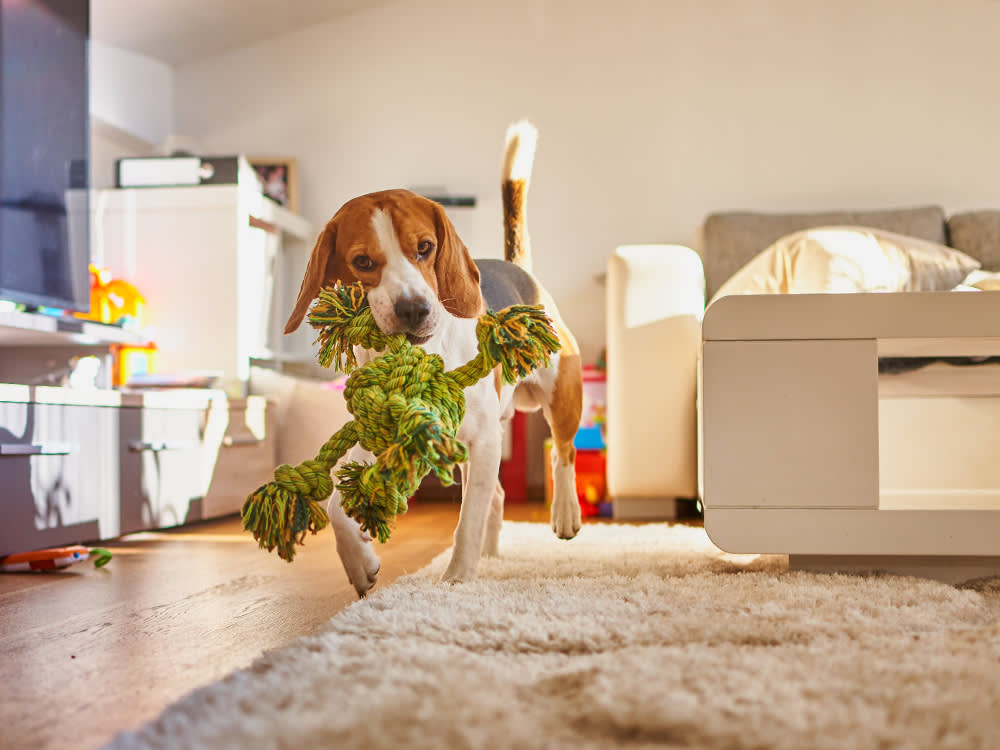
Furniture and Decor Modifications: Creating a Dog-Friendly Home
In this chapter, we embark on the journey of transforming your living space into a haven that caters to both you and your four-legged friend. We’ll explore various ways to make your furniture and decor more dog-friendly, from selecting the right pieces to safeguarding your belongings against the wear and tear that often accompanies a canine companion.
Choosing the right furniture sets the stage for a dog-friendly home. It’s wise to consider furniture with attributes that can withstand the rigors of pet ownership. Durable fabrics, such as microfiber, leather, or outdoor-grade materials, not only resist stains but are also less susceptible to damage from claws and paws. Removable and machine-washable covers are practical additions, simplifying the cleaning process after inevitable pet-related messes. You might even explore sofas designed with pets in mind, featuring built-in pet beds or storage for pet supplies. For dogs prone to scratching or digging, furniture crafted from rugged, scratch-resistant materials can be a wise investment. Additionally, providing your dog with their own comfortable pet bed or specialized furniture discourages them from using yours.
Even with dog-friendly furniture, it’s essential to take proactive measures to protect your cherished belongings from the natural wear and tear that dogs can bring. Training is a fundamental step, teaching your dog not to jump on furniture and encouraging them to use designated pet-friendly furniture or beds. Furniture protectors, such as scratch guards or furniture wraps, shield vulnerable areas from your dog’s sharp claws. Bitter-tasting sprays can be used on surfaces prone to chewing, acting as a deterrent to discourage your dog from gnawing on furniture. Ensuring your dog has access to a variety of chew toys and engaging interactive games helps keep them entertained and reduces the likelihood of furniture chewing. Lastly, regular nail trimming for your dog is essential, as shorter nails can minimize the damage they inadvertently inflict upon your furniture.
Crafting a dog-friendly home need not come at the expense of style. You can seamlessly blend your love for interior design with your pet’s needs. Consider investing in decorative pet crates or kennels that complement your decor, serving as functional furniture pieces that double as pet havens. Choose washable, stain-resistant rugs for high-traffic dog areas, ensuring easy cleanup. Personalize your space with pet-themed art or portraits of your beloved dog, adding a warm and personal touch to your decor. Incorporate stylish storage solutions for pet toys, leashes, and other supplies, keeping your home organized and clutter-free. Wall decals, whether pet-themed or customized with your dog’s name, can infuse a playful element into your decor. To strike a balance between comfort and practicality, select throw pillows and blankets crafted from pet-friendly fabrics.
By implementing these thoughtful furniture and decor modifications, you can create an inviting and stylish home that caters to your dog’s needs while reflecting your unique sense of style. As we delve into the upcoming chapters of this guide, we will continue to explore room-by-room dog-proofing strategies to ensure that your home remains secure and enjoyable for both you and your cherished furry family member.
Kerbl Dog House with Terrace
The Timber Framed Barn Dog Kennel
Queen Anne Dog Kennel
The Kempton Kennel
PetPalace Luxe Furniture Crate
Doghouse Cucciolotta Classic L
Trixie Home Kennel Bench 73x53x53 cm
Indoor and Outdoor Safety Measures: Keeping Your Dog Secure
This chapter delves into the pivotal task of ensuring the safety and well-being of your beloved canine companion within the confines of your indoor and outdoor spaces. We aim to provide practical guidance that allows you to create a secure environment for your dog while being mindful of potential hazards.
When it comes to the interiors of your home, there are several considerations to keep in mind. The use of gates and barriers can help delineate areas where your dog should not venture, effectively safeguarding them from potential hazards. If you’re looking for a more comprehensive approach, crate training can serve as an excellent solution, offering your dog a safe space and minimizing the chances of them getting into trouble. Additionally, managing electrical cords and cables is essential to prevent your dog from chewing on them, and various cord covers and cable clips are available to help keep these items out of their reach. Ensure your cleaning supplies and toxic substances are securely stored with the use of childproof locks or cabinet latches. Lastly, investing in dog-proof trash cans with locking lids can help prevent your dog from accessing garbage that may contain harmful items.
Creating a secure and enjoyable outdoor space for your dog is equally significant. Robust fencing is paramount to safely containing your dog within your yard, ensuring there are no gaps or openings that could serve as escape routes. Selecting the appropriate fence height based on your dog’s size and breed is crucial, as some breeds are known for their jumping or climbing abilities. If your dog has a penchant for digging, taking preventive measures such as burying wire mesh or using concrete along the fence line can help deter escape attempts. Opt for dog-friendly landscaping with non-toxic plants and shrubs, avoiding those that could be harmful if ingested. Designate a safe play area in your yard, free from sharp objects or potentially dangerous plants. Lastly, secure gates that provide entry and exit to your yard, ensuring they are regularly inspected and maintained to prevent inadvertent escapes.
Vigilance and awareness of potential hazards are paramount in ensuring your dog’s safety. Familiarize yourself with common poisonous plants, including lilies, poinsettias, azaleas, oleander, and philodendrons, and consider removing them from your yard if present. Be cautious when handling chemicals like fertilizers, pesticides, and herbicides, ensuring they are securely stored and used in strict accordance with instructions. Due to its sweet taste, antifreeze is highly toxic to dogs, necessitating careful storage and immediate cleanup of any spills. Safeguard all medications, whether intended for human or pet use, by storing them beyond your dog’s reach. Additionally, exercise caution by never leaving chocolate or alcohol accessible to dogs, as both substances can have severe and adverse effects on their health.
In conclusion, by diligently implementing these indoor and outdoor safety measures and maintaining a keen awareness of potential hazards, you can construct a secure and welcoming environment for your dog both inside and outside your home. Subsequent chapters will delve into room-specific dog-proofing strategies, ensuring comprehensive coverage for your beloved four-legged family member’s safety and well-being.
Dog Mate 2-way locking dog
DogSpace Charlie. 105cm extra tall
Dog Space Marley Retractable Dog/Puppy Gate
Dog Barrier with Cat Door 107cm High (to fit 75-87cm opening)
Training and Behavioral Considerations: Ensuring a Harmonious Home
In this chapter, we will delve into the crucial training and behavioral aspects that contribute to creating a dog-friendly home. Our aim is to provide you with insights and strategies for establishing a well-behaved canine companion, managing behavioral challenges and stressors, and emphasizing the significance of exercise and mental stimulation in your dog’s life.
The foundation of a harmonious home with your dog begins with effective training techniques. Obedience training is the bedrock of a well-behaved dog. Commands such as sit, stay, come, and leave it not only shape your dog’s behavior but also strengthen the bond between you and your furry friend. House training is equally pivotal for maintaining a clean and hygienic living space. Using positive reinforcement and consistency to reinforce desirable bathroom habits is the key.
Crate training can offer your dog a secure and comforting space while averting destructive behaviors, especially when you’re not present. It’s essential to ensure the crate is a welcoming and comfortable environment. Early socialization is instrumental in ensuring your dog is at ease around other dogs, people, and varying environments, reducing fear and anxiety in your dog. Leash training is another aspect that contributes to enjoyable and safe walks, benefiting both you and your dog. Embracing positive reinforcement techniques, such as treats and praise, to reward good behavior has been proven to be more effective and humane compared to punitive measures.
Addressing and managing behavioral challenges is integral to a harmonious home. Separation anxiety is a common issue among dogs, and gradual acclimatization to being alone, along with creating a comfortable space with toys and a cozy bed, can help alleviate this anxiety. Managing destructive behaviors, like excessive chewing, involves providing appropriate chew toys to redirect their tendencies. Ensuring your dog receives ample exercise and mental stimulation is vital in preventing boredom-induced destruction. Excessive barking can be triggered by various stimuli, and identifying these triggers and working on desensitization can be effective. In cases of persistent barking, professional training may be beneficial. Aggressive or fearful behavior requires immediate attention and prioritizes safety; consulting a professional dog trainer or behaviorist is crucial in such instances. For dogs sensitive to thunderstorms or fireworks, creating a secure, quiet space during such events can provide comfort. The use of white noise or calming music can help mask unsettling sounds.
Physical exercise and mental stimulation are cornerstones of a dog-friendly home. Regular physical exercise is vital for your dog’s overall health and behavioral well-being. Daily walks, playtime, and opportunities for running and exploration are essential components of this. Mental engagement is as crucial as physical exercise, and incorporating puzzle toys, treat-dispensing toys, and obedience training sessions will keep your dog’s mind active and engaged. Establishing a daily routine that encompasses exercise, feeding, and playtime is pivotal. Dogs thrive on consistency, and a structured routine can alleviate anxiety. Engaging in interactive play activities with your dog, such as fetch or hide-and-seek, not only strengthens your bond but also provides both mental and physical stimulation.
By implementing these training techniques, effectively managing behavioral issues, and ensuring your dog receives adequate exercise and stimulation, you’ll create a harmonious and dog-friendly home where your furry companion can thrive as a well-behaved member of the family. In forthcoming chapters, we will continue to explore room-specific dog-proofing tips to comprehensively cover all aspects of your home.
Conclusion
In this comprehensive guide, we have delved into the crucial elements of creating a secure and inviting home for your canine companion. Let’s revisit the key takeaways and reinforce the importance of crafting a sanctuary that caters to your dog’s well-being.
Throughout this guide, we have underscored the significance of understanding your dog’s needs. This foundational knowledge involves recognizing their behavior and instincts, as well as identifying potential hazards from their unique perspective. By doing so, you lay the groundwork for a harmonious living environment that meets their physical and emotional requirements.
We explored the essentials of dog-proofing, covering everything from evaluating your home for potential dangers to establishing a safe and enjoyable indoor and outdoor space. We discussed the critical importance of selecting dog-friendly furniture, safeguarding your possessions, and integrating pet-friendly decor seamlessly into your living space. Additionally, we dived into training and behavioral considerations, highlighting the value of basic training techniques, the management of behavioral challenges, and the essential role of exercise and mental stimulation in your dog’s life.
Creating a dog-friendly home is a labor of love, one that yields immeasurable rewards. Your dog is not just a pet but a cherished member of your family. By dedicating yourself to dog-proofing your home and providing an environment that is secure, comfortable, and stimulating, you are ensuring their happiness and overall well-being.
A dog-friendly home serves as a sanctuary where your dog can flourish, feeling loved, secure, and valued. It becomes the backdrop for the strengthening of your bond, where each day brings joy and companionship in your shared journey.
As you embark on this endeavor, remember that creating a dog-friendly home is an ongoing process. Just as your dog evolves and matures, so will your dog-proofing efforts. With love, patience, and sustained care, you can provide your beloved companion with a haven that truly feels like home.
To further enrich your knowledge and guarantee your dog’s safety and happiness, consider exploring additional resources:
Professional Training: Enroll in obedience classes or seek guidance from a certified dog trainer or behaviorist for specific training or behavioral concerns.
Books and Guides: There is a wealth of literature available on dog training, behavior, and pet-proofing your home. Seek reputable sources to expand your understanding.
Online Communities: Engage with online forums and communities tailored to dog owners. These platforms offer invaluable insights and support from seasoned dog enthusiasts.
Veterinarian Advice: Maintain regular consultations with your veterinarian for health and safety advice tailored to your dog’s specific needs.
In closing, the pursuit of a dog-friendly home is a rewarding and ongoing journey. With dedication and attention, you can create a haven for your furry companion that ensures their happiness and well-being for years to come. Cheers to a life filled with shared love and memorable moments!

